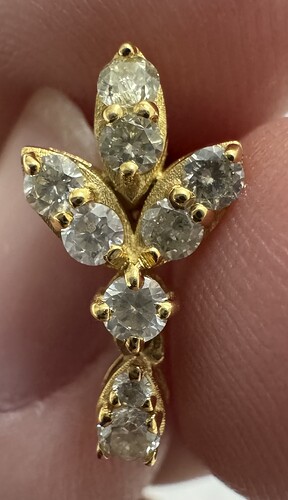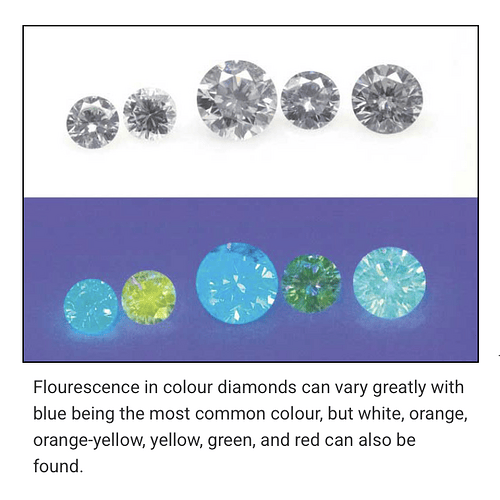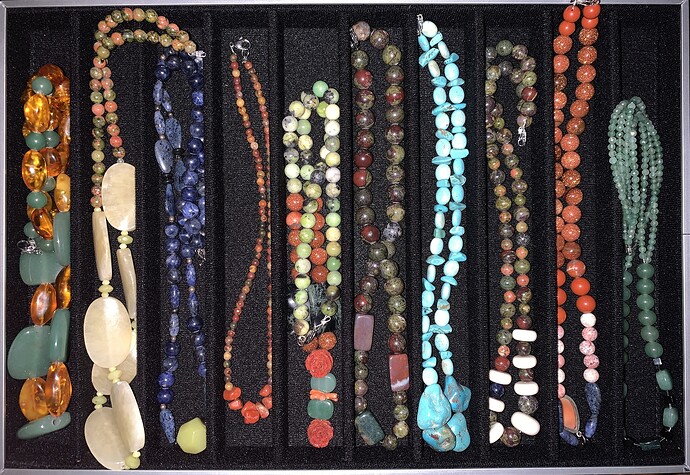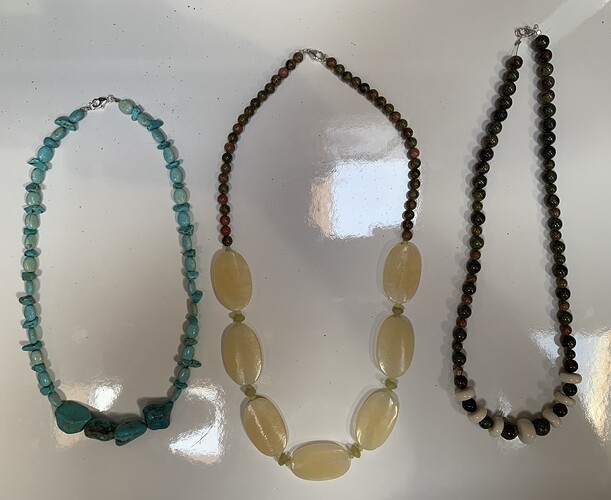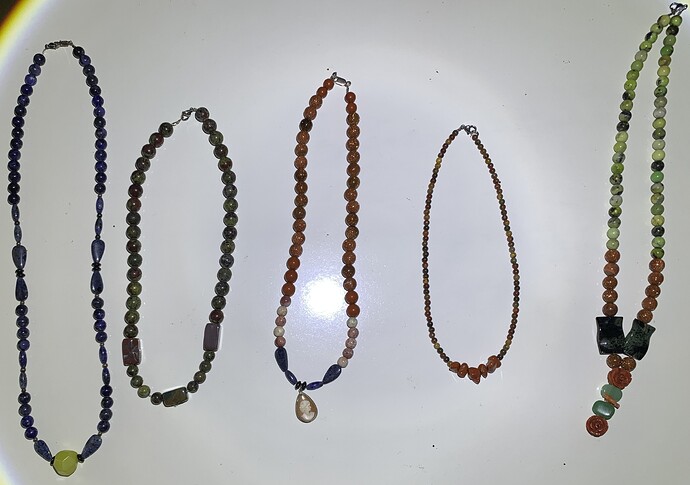These earrings are sold as diamond earrings but very doubtful they are. They have a very yellow fluorescence under UV light. Any help is appreciated.
Hi May,
Welcome to the forum!
Do you know what UV wavelength your lamp provides?
There is some literature on natural and lab grown diamonds that produces yellow fluorescence. Here is a good article from the GIA:
https://www.gia.edu/gems-gemology/winter-2024-fluorescence-phosphorescence.
Do you have other diagnostic instruments available? A specific gravity test would help.
Cheers!
-Troy
I believe it’s a 395nm. Thanks a lot for the link, what’s weird is that all the stones have the yellow fluorescence, not just a few… still unsure.
365nm is the typical LW UV but anywhere within a +/- 10nm is common. Not sure if 395 is too far out of norm to cause a different behavior.
Possible simulants; YAG and GGG do not typically fluoresce yellow, however, Cubic Zirconia can.
If you can dismount one of the stones from its prongs, a specific gravity test will be a very good diagnostic.
A diamond tester, even some of the cheap ones on Amazon, can distinguish CZ from natural without removing the stones from the setting.
Cz glows orange yellow under longwave, greenish yellow under shortwave.
Moissanite is greenish yellow under longwave. Strontium titanate, which is no longer made in any quantity has no instrinsic florescence… colors depend on dopants. Cz is the most common simulate and has greater dispersion than diamond. It’s also the cheapest to create. As Troy mentioned, easily distinguishable for diamond with a electrical and thermal conductivity testing.
Good reference, in fact a great reference.
For more general information on mineral flourence and phosphorence, with a specific chapter on gemstones look to the issue published in April/May in the bimonthly issue of ELEMENTS, the official newsletter of the European Association of Geochemical Societies… EAG is 100% science and research…Membership is automatic, including access to publications, when attending the Goldschmidt annual geochemical societies meeting… The last meeting was summer of 2024 in Chicago. 2025 is in Prague, Czech Republic…Next North American meeting in Montreal in 2026, Paris, France in 2027…this is just FYI.
Correct me if I’m wrong please!.. it’s my understanding that light blue is the most common color for flourencence in colorless Type 1A diamonds. Yellow is usually light, caused by a vacancy next to a nitrogen subsitution in the crystal lattice… shsortwave UV brings out flouresence, not so much long wave…the jewerly piece shows intense yellow green… what is your opinion? The original post doesn’t specific short or long wave. Thanks for any corrections and misconceptions on my part… I’m here to learn form an expert… which I’m far from…
that’s very intense… can you specify short or long wave UV? This if for M, original post picture
my previous post was directed to you… please help us all understand… you’re THE expert on this thread… thanks
Sorry I just saw this. The picture was taken under long wave UV light. It is super yellow exactly as the picture shows.
I would think that the intense yellow makes it look more like CZ. I’m waiting of Jbergman to respond… he’s the expert.
Distinguishing simulants from diamond is easy with a diamond tester. Cheap brands on Amazon are good enough… Diamond has the highest thermal conductivity of any material… higher than silver. Despite the high thermal conductivity, electrical conductivity is very low…if you can remove one of the stones and put it back safely, a specific gravity measurement will also easily distinguish it from CZ…CZ is much heavier and denser…the caveat with diamond testers is that they cannot distinguish synthetic diamond from natural. they both have identical physicochemical properties as both are diamond…
I am no expert in diamond fluorescence, so I suggest you read:
Nitrogen defects are the most common cause of fluorescence:
- Blue fluorescence is caused by N3 centers. They will generally show a 415nm absorption line in the spectrum. Blue fluorescence is the most common and is only in Type Ia diamonds. Green fuorescence is caused by H3 or H4 centers. H3 is an A aggregate trapped by a vacancy. H4 is a B aggregate (3 N trapped by a vacancy in Type Ia. They will have 503 o4 496 nm absorption line.
- Yellow fluorescence is caused by carbon structures called platelets or hydrogen impurities in type Ia.
- Orangey-yellow is caused by single N atoms replacing C.
- Orange is caused by a NV center with no charge (nitrogen trapped by a vacancy)
- Pink/red is caused by a NV- center (NV with a negative charge).
- Red is caused by boron in Type IIb diamonds. I may also cause red phosphorescence.
- Type IIb diamonds may show a weak blue fluorescence even though they show no measurable N.
- High levels of A aggregates can quench fluorescence. Since Type IaA and Type IaAB are the most common I think this is why only about one third of all diamonds will be fluorescent.
- There are other causes that are not well understood. For example Chameleon diamonds which show color change from mild heat or storage in the dark can fluoresce intense yellow in LW, faint yellow in SW and phosphorescence for 30 to 60 seconds after exposure to SW. Mixed types of diamonds are common and this may affect fluorescence as well.
Natural diamonds generally fluoresce with exposure to LW and may be weak or inert in SW. Lab created (synthetic) diamonds generally fluoresce with exposure to SW and may be weaker or inert in LW. Some HPHT Lab diamonds will not fluoresce under either LW or SW but after exposure to SW may have a weak greenish phosphorescence for 10 to 30 seconds.
This article was originally published on Nature’s Rainbow.
The above was taken from an abstract in the Flourecent Mineral Society’s website.
How florescence itself is created is difficult to understand for most people, including myself. Flourence is a quantum phenomenon. Electron excitation followed by relaxation and emission of visible light follow quantum energy levels. Defects in a crystal lattice caused by impurities/substitution/vacancies/holes cause losely bound electrons to absorb in the UV band and reemit energy as visible light after dropping down to intermediate energy levels to baseline. Even more complex is crystal field splitting of energy levels in transition metals…this does NOT happen with diamonds…transition metal impurities are not present and the tetrahedral or cubic lattice with coordination number of 4, does not permit cystal field splitting. The bonding energy is too high…This mechanism IS important in colored gemstones, including beryls, corundum.
Thank you so much!
thanks, this is the reference that I also found… thanks for posting the link to the FMS website…the other publications will be useful…
the article that I cited in part is what jbergman posted in full… click on the article for a full reading…
UV light can cause pink florescent in corundum refered as Ruby when pigeon blood color exists with UV off. UV on bright pink occur due corundum within, the gem could be man made or natural depends on region originally from.
GIA has stopped stating origination location due counterfeit gemstones submitted for validation.
I acquired 120+ Rubies; 52 were lab created simply due perfection. 62 were natural simply because none would put into high end jewelry to many inclusions. Moissanite acquired 100+ carats all validated by sample submission of gems for validation by GIA, validated Moissanite.
35% natural acquired
35% Labratory acquired
30% glass acquired
Buyer beware.
Of those acquired 2024 sales tax bill $856
Sales tax paid.
I create for retailers.
Most often change minds as often as change underwear.
Often offered 5% of what they will retail items for.
This is my hobby. I am fine with offers at 5% of retail. Rather get more but doing out of my love of creation.
Diamonds can be yellow, pink, blue, red, brown, black any color of rainbow.
Diamonds are most common substance on Earth.
Price point Diamond higher than Ruby.
I Acquired 1,200 carats of Ruby.
Finished 50 items for our gemology & mineral show tomorrow & Sunday at Escondido Center for the Arts.
34 necklaces 16 bracelets
If get $100 necklace would be happy.
Use a Gem refractometer to determine type.
Use a hardness meter to determine ranged type.
Might be range of colored Diamond if tested as Diamond.
Submit to GIA to be tested by them.
Mounted items can be expensive to submit.
Go to nearest Gemological Society group near you and ask group members to test while you observe testing.
They might teach you several factors while doing so.
